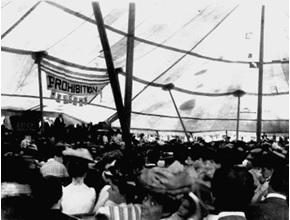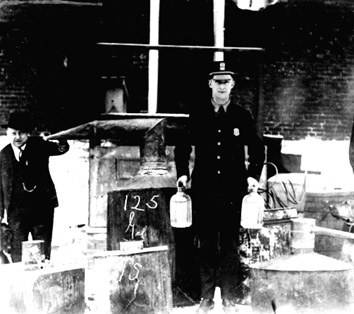
A travelling exhibit, the first in a series, will be coming to the Bowman Library on December 10th. On loan from the Library of Virginia, the exhibit is called Teetotalers & Moonshiners: Prohibition in Virginia, Distilled and consists of a series of informative banners on the Prohibition Era in Virginia from 1916 to 1933. It will be featured in the lobby of the Bowman Library for the next month and a companion exhibit which was prepared by our archivists will be on display at the Handley branch on the lower level outside of the Stewart Bell Jr. Archive.
Prohibition marked the period in U.S. history when the production, transportation, possession, and sale of alcohol was illegal throughout the country. Decreed by the 18th amendment to the Constitution in 1919, Prohibition launched a new counter-culture of speakeasies and organized crime that revolved around the black market distribution of alcohol. The era spawned new music and fashions and a new air of free-spirited defiance in young people and women in particular. At the same time, the temperance movement preached sobriety and the ills of alcohol, led primarily by the Women’s Christian Temperance Movement. The state of Virginia was an early adopter, having gone dry by 1916, which was three years before national Prohibition went into effect. The Prohibition movement in Virginia had much earlier roots than that, in fact, as the photo above shows. It is included in the archival exhibit and pictures a prohibition tent meeting in nearby Purcellville in 1901.
As part of an official press release, the Library of Virginia wrote:
Virginians imbibed their last legal drink on Halloween night in 1916— more than three years before national prohibition was enacted. Newspapers reported bacchanalian scenes in the Old Dominion’s cities as “wets” drank up and bought out the stock of saloons and bars. Most of the state’s liquor, beer, and wine producers quietly shut down. Many farmers worried that a major part of their livelihood from corn and fruit had disappeared overnight, while supporters of prohibition exulted in the promise of a morally upright “Dry Virginia.” For the next 18 years the state became a laboratory for a grand social experiment that ultimately left many Virginians with a serious hangover— and eventually led to repeal.

The companion exhibit will be housed in the cases outside of the Stewart Bell Jr. Archives for the duration of the main exhibit. It consists of a number of photographs, documents, and several artifacts from our archival collections, including stoneware moonshine jugs and flasks. While the main exhibit encompasses the entire state of Virginia, the archival exhibit focuses primarily on Winchester and the surrounding region. Both exhibits are available to view at any time during regular library hours. Keep an eye on our calendar for updates about related programming!
At left, Winchester Sheriff Luther Pannett supervises and restrains a bloodhound while J. Thomas Boyd (center with jugs) confiscate the products of an illegal moonshine still. Circa 1920's. This photo is also on display in the archival exhibit.
This exhibit has been prepared by the Library of Virginia with support from the National Alcoholic Beverage Control Association, the Virginia Alcoholic Beverage Control, and the Virginia Distillers Association.